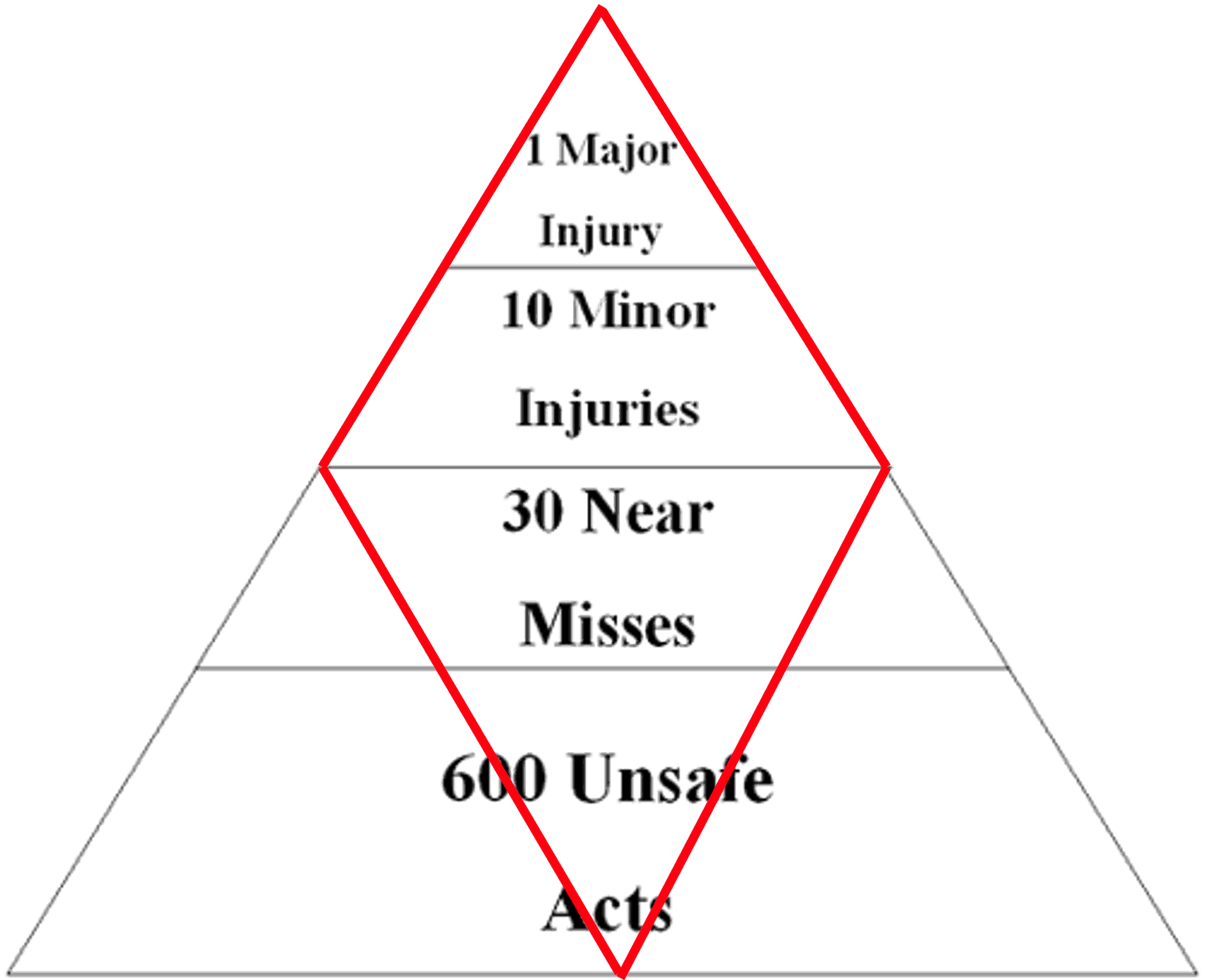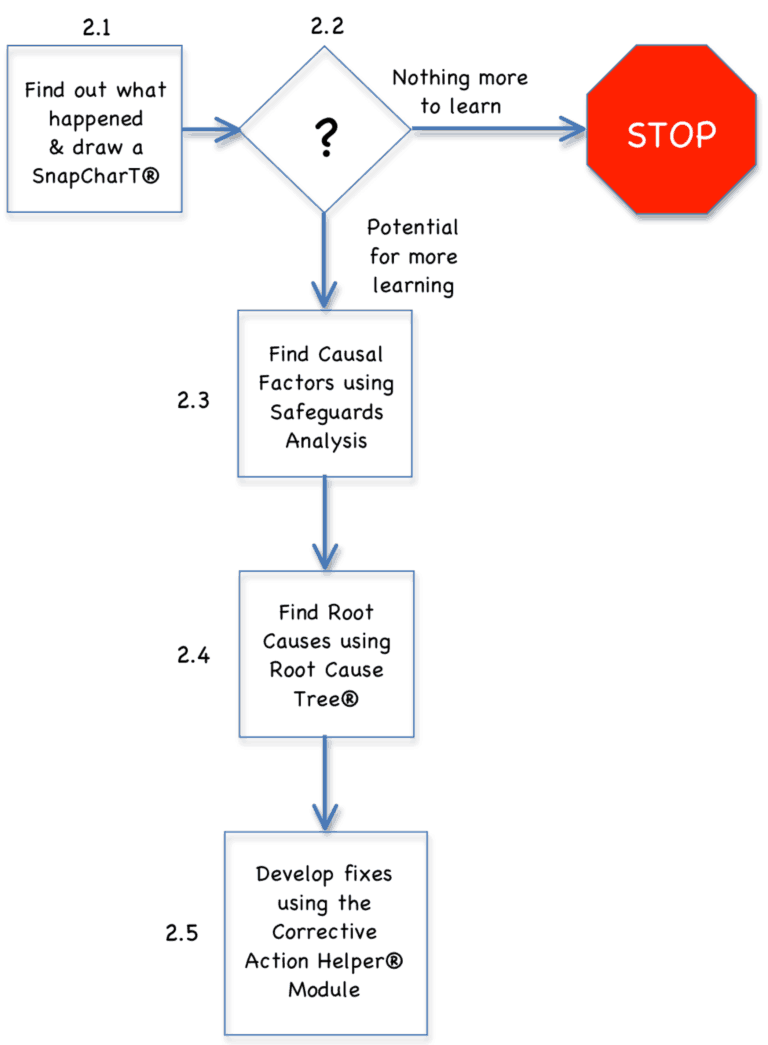Deciding When to Investigate a Precursor Incident (What’s in the Diamond?)

Understanding Precursor Incident Severity
Explaining the Old Pyramid
First, before we explain the diamond pyramid (shown above), let’s look at the history of the Accident Pyramid and its modifications that led to the Diamond Pyramid. This will lead us to a way to evaluate the severity of precursor incidents.
The first Accident Pyramid was developed by H.W. Heinrich. In 1950 he published the following figure in his book, Industrial Accident Prevention, 3rd edition:

The data came from his experience in the insurance industry in the 1920s and early 1930s. (Not exactly a recent source of research.) He never provided the statistics to prove the figure but, it was accepted for many years as being generally true.
Not what the explanation under the figure says.
“The 300 accidents shown in the lower block
are not merely unsafe practices. They are all
falls or other accidents which resulted in
narrow escapes from injury.”
This is important and seems to be forgotten when others modified the Heinrich Accident Pyramid.
For example, Frank Bird published this modification to Heinrich’s Accident Pyramid in his book, Loss Control Management: Practical Loss Control Leadership that was published in 1969:

There was no note about the near-misses or unsafe acts being precursors of a major injury.
Later, the pyramid was more extensively modified to explain behavior-based safety. In 1990, Krause, Hindley, and Hodson published this pyramid in their book, The Behavior-Based Safety Process:

Again, the idea that each OSHA Recordable, First Aid Case, or Behavior could cause a fatality seems to have been lost in the drawing and use of this pyramid.
Challenging the Pyramid
In the October 2011 Issues of Professional Safety (published by the American Society of Safety Professionals), safety expert Fred A. Manuele challenged the basis for Heinrich’s Accident Pyramid and the subsequent modifications to the pyramid.
The first challenge was that unsafe acts of workers are not the main cause of occupational accidents. The second challenge was reducing the lower categories on the pyramid would reduce fatalities.
In the article, Fred Manuele also states:
“Causal factors for low-probability/high-consequence events are rarely represented in the analytical data on incidents that occur frequently, and the uniqueness of serious injury potential must be adequately addressed. However, accidents that occur frequently may be predictors of severity potential if a high energy source was present (e.g., operation of powered mobile equipment, electrical contacts).”
I don’t disagree with Fred’s statements. But I do disagree with the conclusions that others reached about the Accident Pyramid.
The New Accident Pyramid – The Diamond Pyramid

After the criticism from Fred Manuele, safety professionals started rethinking the Heinrich Accident Pyramid and came up with the theory of “mining the diamond.”
What does “mining the diamond” mean? They took the inaccurate model that includes near-misses and potential problems (unsafe acts in the diagram above) and drew a diamond on it. The diamond indicates that only a small fraction of the lowest level of unsafe acts could actually become major injuries.
This seems to indicate that the shape of the actual precursor pyramid is a diamond rather than a triangle (although some show the diamond as a skinny triangle).
The argument seems to be about the shape of the pyramid. And this argument goes back to which precursor events could realistically become fatalities or major injuries … and thus, severity.
I don’t agree with the point on the bottom of the diamond. But I do agree that the inaccurate pyramid is wrong. But where does that lead us and what does it have to do with deciding which incident is a precursor incident? Continue reading to discover ENERGY THEORY.
Energy Theory
A new energy theory has been proposed that only incidents involving hazards with certain minimum energy should be investigated to prevent a fatality or a major injury. For example, if someone falls off a single step, this is unlikely to cause a significant injury because the energy is too low.
To keep this new theory based on science rather than guesswork, people separating real precursor accidents from minor incidents must calculate the energy necessary to cause a major injury for a variety of different types of energy. This can help you can consistently calculate what is inside the diamond and what’s outside the diamond.
Dr. Matthew Hallowell from the University of Colorado, Boulder (also working with the Construction Safety Research Alliance), is working on these calculations for the energy types shown on the Energy Wheel below (from the Safety Function website)…

This idea is just one way to help people decide if a precursor incident is worth investigating. To cause a, the work must have enough energy to cause afatality or significant injury.
In theory, one can calculate the energy and evaluate how much energy is required to cause a fatality or significant injury. And that is the follow-on work being performed by the Construction Safety Alliance.
How Important is Consistency to You?
The ability to rate the significance of a near-miss and decide to call it a precursor Incident that needs a thorough investigation takes considerable effort. You need to ask yourself,
How important is consistency to you?
In the investigation of low-to-medium consequence incidents, you need to decide if there is something to learn in the TapRooT® Process shown below…

Thus you could use his energy theory to try to get a consistent answer to the question in the decision diamond, step 2.2 (Is there something to learn?). You will only continue the investigation if there are more than 2000 Joules of energy involved in the incident. (Of course, this varies by type of energy.)
For our pothole example in the parking lot (in our 2-Day TapRooT® Root Cause Analysis Course), the 85Kg X 1 Meter X 9.8 = 833 Joules. This means we could justify stopping the investigation after we have drawn our basic SnapCharT®.
Can You Be More Consistent in Judging What is a Precursor Incident?
What do you think? Will you use the calculation method suggested by Dr. Hallowell? Or will the concept alone (without actual calculations) help you be more consistent?
We hope this explanation will help you think more clearly when making the decision:
Is There Something More to Learn Here?
And also improve your thinking about ways to reduce or modify the energy as part of developing corrective actions! (We often talk about removing/reducing the Hazard (energy) when developing corrective actions).



